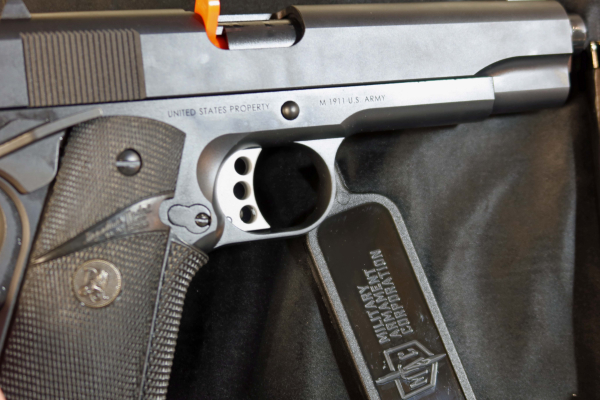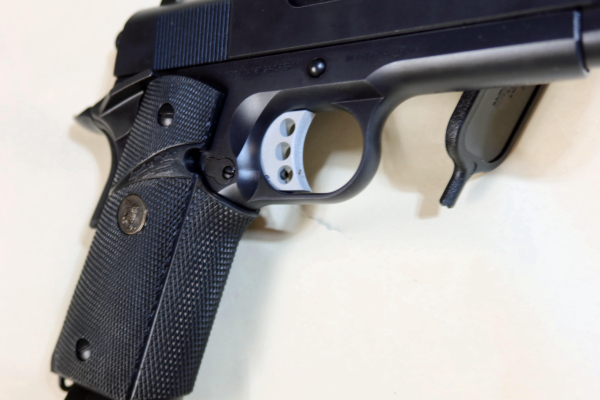As reported in a recent 1911 installment, I’ve been seeking to replicate a kind-of junky parts-bin gun I had over forty years ago. Built by a coworker, it was based on an early Essex cast frame – there were “runs” in the steel – and a Colt slide. Fitted with high, fixed Micro sights with a hardball front sight, it featured MS-Safari bilateral thumb safety levers, a fitted bushing, a long, solid trigger, a smooth, flat mainspring housing and a Metaloy (think industrial hard chrome) finish. He’d put a set of stocks from a 1970s Colt Combat Commander – “Coltwood,” they were smooth with no checkering.
I actually carried that gun a bit on duty. It was reliable with hardball and with late-1970s era Remington 185 grain JHP factory ammo.
I really liked it, but a state trooper took a fancy to it. In the manner of the oft-told tale, he promised to sell it to me if he ever got rid of it.
Is that one of the three biggest lies?
No matter. There are lots of 1911s. My first attempt to find a reliable, duty grade 1911 was a 1996 Kimber Custom Classic. Marked “Clackamas, OR,” it only failed in that it had the full-length guide rod, something that grates on me.
Recently, I became aware of the SDS Arms/Tisas “Stakeout.” Not the shiny 9mm/38 Super version (which has its own appeal), the Stakeout was 45 ACP, QPQ finished with a gold bead front sight, a near copy of the fixed Micro and wood stocks.
As one might expect, they quit making it before I got around to it.
Now, I found the SDS Arms/Military Armament Corporation MEUSOC replica.
For those not into initialism, that’s Marine Expeditionary Unit-Special Operations Capable. It’s supposed to copy “the finest close quarters battle weapon,” to quote a mentor.
This just-over-37 ounce 45 Auto has the QPQ finish (think “Tenifer”), vertical slide serrations, target-crowned barrel, and “enhanced GI style sights” (more like high fixed Micro rear with the corners rounded – a nice touch) with a ramp front sight.
The MEUSOC modified GI 1911 pistols of that era (1985) had Pachmayr rubber wrap-around stocks. This gun has period-correct Pachs – and they are thick as I remember them, with no thinned channel to the mag catch.

Above, the MEUSOC has “United States Property” marking. Below, the profile is M45 MEUSOC, all the way, including Pachmayr stocks and a lanyard ring.
The first of the guns modified date from around 1985, according to sources, and were known as the M45. My old parts-bin gun predated the execution if not the concept.
I was able to source a sample of the MAC MEUSOC replica from SDS Arms/MAC. I am impressed with it. It’s nicely finished and seemed to be well-fitted. Unlike the company’s earlier JSOC replica, this gun features a blackened barrel. Like the JSOC, this is more gun than the cost implies.
For my first rounds fired in this, the latest pistol shipped to me for purposes of writing an article, I took it along with a refreshed 1996 Kimber Custom Classic, the first pistol shipped to me for gun writing purposes.

The look-alike “Videcki” trigger and bilateral safety levers are also correct for vintage.
I shot old-stock PMC 230 grain FMJ, which produced a vertical string from the Ransom Multi-Cal. rest. The group measured at 3 ¼”, with the best three hits in 1 7/8” from 20 yards. The sights, wonderfully rendered, were dead-on for the range and cartridge.
I tried some Cor-Bon 200 gr. JHP +P (old stock), one-handed for function … wow! Aside from the SNAP of the recoil, the gun functioned with them. I tried Federal 230 gr. HydraShok HP, fired the same way. With that load, it was the old 45 Auto “push,” not a “snap.”
The ammo tried thus far fed through the factory-supplied 8-shot magazines.
I followed up with an old box of Speer GD 200 gr. +P, and it was likewise snappy.
An old stainless magazine from 1980, marked “Colt” on the floorplate (I don’t think Colt made it or sold it) was also reliable in the new gun.
I did a bit of a handling drill, consisting of close range “bent-arm” shooting, hits to a high-value scoring zone, one from the holster (Galco Avenger belt holster) and one from low ready, along with a failure to stop exercise, a reloading stage and some mid-distance work. The target was the Birchwood Casey EZ-Scorer 12” x 18” IPSC Practice Target. Being a reduced size target (the center A-zone is about 3 3/8” wide by 6 ¼” high), accuracy was more the standard than speed.
It was a good thing too.
I used the Speer Gold Dot JHP +P load; it’s left-over from earlier times. It still shot fine, a very solid recoil pulse. Up close I pulled two C-zone hits from the bent arm position. These were both follow-up shots and both tended left. As the gun torques left when shooting one handed – naturally – this wasn’t surprising. The 7-yard singles to the head box (3 3/8” x 3 3/8”) were both low, shooting under the sights. At ten yards, the failure to stop drill produced good hits, including the one in the 2 ¼” x 1 1/8” upper A-zone. That left a round in the gun. From low ready, I fired it, did a reload and fired another.
The comedy of errors; I had trouble reaching the magazine release, then failed to seat the (supplied) magazine. They both have bumper pads, but leave it to me to fail to seat it. I did – tapped the floorplate, racked the action and fired again. At fifteen yards, I fired a four-shot string from the holster followed by singles from low ready until empty.
Twenty rounds fired in a handling drill. What did I learn?
I was down six points and was very slow – I suppose I’m used to a 9mm world.
The trigger on this gun feels odd in action, like there are two stages to the press. The width of the Pachmayr stocks keep me away from the mag catch and mess up my “point.” I also found myself failing to positively depress the grip safety.
While there may need to be some adjustment to get early deactivation of the grip safety, I think it’s the way my hand fits over the Pachmayrs; years ago, the company made wrap-around 1911 rubber stocks that were a little thinner, with a depression for the thumb to reach the mag release.
That’s not what came on the MEUSOC and I imagine that MAC was trying to be faithful to this generation of the MEUSOC pistol. I’ll change stocks for a comparison shoot with the same firm’s JSOC pistol and report back.
Meanwhile, the gun has run with non-supplied magazines, with ball and with hollow-point ammunition. While I’m not the most competent hand with it, it seems to want to shoot and I’m going to let it.
— Rich Grassi